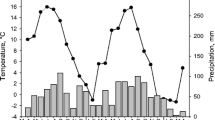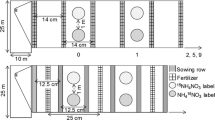Abstract
Red clover material labelled with15N was confined in mesh bags and buried into microplots in October at two field sites in Sourthern Finland. The soils (Kettula silt loam and Långvik loam) contained in the microplots were previously limed and fertilized with PK (N was given in next May) in different combinations. The following May the microplots were sown with barley and after the barley had been harvested (that August) soil samples and the mesh bags were removed. The crop, mesh bags and soil were then analysed for15N content.
The soil treatments did not affect the release of clover N from the mesh bags and only slightly its retention in Kettula silt loam. The dry mass of barley obtained responded strongly to the different soil treatments. In comparison, the uptake of clover N by the barley varied much less; in Kettula silt loam a 1.6 fold increase in barley dry mass did not affect its content of clover N (12–13% of input) and in Långvik loam a ten fold increase in barley dry mass yield corresponded to a three fold increase of the content of clover N (5–16%). The total recovery of clover N (clover N in soil+mesh bags+barley harvest) was almost independent of the soil treatment; in Kettula silt loam and Långvik loam being respectively 52–56% and 71–85% of the input.
Similar content being viewed by others
References
Adams F 1984 Crop response to lime in the southern United States.In Soil Acidity and Liming. Ed. F Adams. pp 211–266. American Society of Agronomy. Madison, Wisconsin.
Awad A S and Edwards D G 1977 Reversal of adverse effects of heavy ammonium sulphate application on growth and nutrient status of a kikuyu pasture. Plant and Soil 48, 169–183.
Cornfield A H 1959 Mineralisation during incubation of the organic nitrogen compounds in soils as related to soil pH. J. Sci. Food Agric. 10, 27–28.
Dommergues Y R, Belser L W and Schmidt E L 1978 Limiting factors for microbial growth and activity in soil.In Adv. Microbiol. Ecology. Ed. M Alexander. pp 49–104. Plenum Press, New York.
Edmeades D C, Judd M and Sarathchandra S U 1981 The effect of lime on nitrogen mineralization as measured by grass growth. Plant and Soil 60, 177–186.
Jansson S L and Persson J 1982 Mineralization and immobilization of soil nitrogen.In Nitrogen in Agricultural Soils. Ed. F J Stevenson. pp 229–252.
Jenkinson D S 1977 Studies on the decomposition of plant material in soil. V. The effects of plant cover and soil type on the loss of carbon from14C labelled ryegrass decomposing under field conditions. J. Soil Sci. 28, 424–434.
Ladd J N and Amato M 1986 The fate of nitrogen from legume and fertilizer sources in soils successively cropped with wheat under field conditions. Soil Biol. Biochem. 18, 417–425.
Ladd J N, Oades J M and Amato M 1981 Distribution and recovery of ntirogen from legume residues decomposing in soils sown to wheat in the field. Soil Biol. Biochem. 13, 251–256.
Moore A W 1974 Availability to rhodesgrass (Chloris gayana) of nitrogen in tops and roots added to soil. Soil Biol. Biochem. 6, 249–255.
Müller M M and Berg B 1988 Release of carbon and nitrogen from decomposing roots of red clover as affected by liming of soil. Plant and Soil 105, 149–152.
Müller M M 1987 Leaching of subterranean clover-derived N from a loam soil. Plant and Soil 102, 185–191.
Müller M M 1988 The fate of clover-derived nitrogen (15N) during decomposition under field conditions: effects of soil type. Plant and Soil 105, 141–148.
Müller M M, Sundman V, Soininvaara O and Meriläinen A 1988 Release of nitrogen from agricultural plant materials decomposing under field conditions: effect of chemical composition of the material. Biol. Fert. Soils. 6, 78–83.
Müller M M and Sundman V 1988 The fate of nitrogen (15N) released from different plant materials during decomposition under field conditions. Plant and Soil 105, 133–139.
Nyborg M and Hoyt P B 1978 Effects of soil acidity and liming on mineralization of soil nitrogen. Can. J. Soil Sci. 58, 331–338.
Reid J B and Goss M J 1983 Growing crops and transformations of14CO2-labelled soil organic matter. Soil Biol. Biochem. 15, 678–691.
Smith D 1981 Forage Management in the North. Kendall/Hunt Publishing Company, Toronto, Canada.
Sparling G P, Cheshire M V and Mundie C M 1982 Effect of barley plants on the decomposition of14C-labelled soil organic matter. J. Soil Sci. 33, 89–100.
Stotzky G and Norman A G 1961 Factors limiting microbial activities in soil. Arch. Mikrobiol. 40, 341–382.
Szegi J, Gulyas F and Füleky G 1984 Influence of soil properties on the biological activity. Zbl. Mikrobiol. 139, 527–536.
Vallis I 1983 Uptake by grass and transfer to soil of nitrogen from15N-labelled legume materials applied to a rhodes grass pasture. Aust. J. Agric. Res. 34, 367–376.
Author information
Authors and Affiliations
Rights and permissions
About this article
Cite this article
Müller, M.M. The fate of clover-derived nitrogen (15N) during decomposition under field conditions: Effects of liming and fertilization. Plant Soil 111, 121–126 (1988). https://doi.org/10.1007/BF02182045
Received:
Revised:
Issue Date:
DOI: https://doi.org/10.1007/BF02182045




